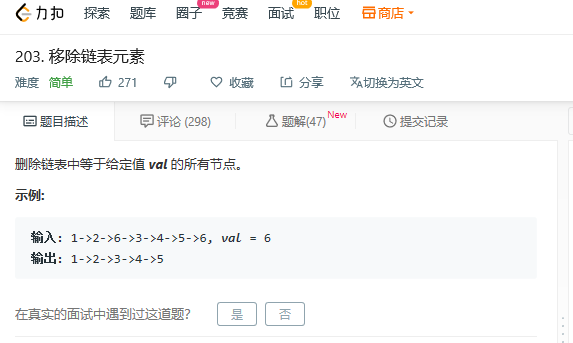Procedures are good or bad:
The first principle is: Speed up
The second principle is: less memory
The third principle is: data should be small
There are several ways of timing programs
1) clock() function of C++, header file is time.h
This timing method is based on the CPU clock as the timing unit, also known as wall time.
The timing method is:
clock_t start=clock()
clock_t finish=clock()
total_time=(double)(finish-start)/CLOCKS_PER_SEC
2) Millisecond-level accuracy of <boost/timer.hpp> (best use)
timer t // declare timer, start timer
...
t.elapsed()// the elapsed time of output, in s
3) Functions of Libraries
Procedure consumed memory:
It can be obtained in the following way:
2.1)ps aux
2.2) top (best use)
2.3)pmap -d $pid
pid is the pid of the current program, which can be obtained by 2.1)


The first way of thinking
Using virtual header nodes
package Soution;
public class Soution1 {
public ListNode removeElements(ListNode head,int val) {
while(head!=null&& head.val==val) {
ListNode delNode = head;
head = head.next;
delNode.next =null;
}
if(head ==null)
return null;
ListNode prev = head;
while(prev.next!=null) {
if(prev.next.val ==val) {
ListNode delNode=prev.next;
prev.next=delNode.next;
delNode.next = null;
}
else
prev = prev.next;
}
return head;
}
}
The second way of thinking
Do not use virtual header nodes
package Soution;
public class Soution11 {
public ListNode removeElements(ListNode head,int val) {
ListNode dummyHead = new ListNode(-1);
dummyHead.next = head;
ListNode prev = dummyHead;
while(prev.next!=null) {
if(prev.next.val ==val) {
prev.next=prev.next.next;
}
else
prev = prev.next;
}
return dummyHead.next;
}
public static void main(String[] args) {
int[] nums = {1,2,6,3,4,5,6};
ListNode head = new ListNode(nums);
System.out.println(head);
ListNode res = (new Soution11().removeElements(head,6));
System.out.println(res);
}
}
The third way of thinking
recursion
package Soution;
public class Soution111 {
public ListNode removeElements(ListNode head,int val) {
if(head==null) {
return null;
}
ListNode res =removeElements(head.next,val);
if(head.val==val)
return res;
else {
head.next =res;
return head;
}
}
public static void main(String[] args) {
int[] nums = {1,2,6,3,4,5,6};
ListNode head = new ListNode(nums);
System.out.println(head);
ListNode res = (new Soution111().removeElements(head,6));
System.out.println(res);
}
}
Code optimization
package Soution;
public class YouHuaSoution111 {
public ListNode removeElements(ListNode head,int val) {
if(head==null) {
return null;
}
head.next =removeElements(head.next,val);
if(head.val==val)
return head.next;
else {
head.next =head;
return head;
}
}
public static void main(String[] args) {
int[] nums = {1,2,6,3,4,5,6};
ListNode head = new ListNode(nums);
System.out.println(head);
ListNode res = (new Soution111().removeElements(head,6));
System.out.println(res);
}
}
Continue to optimize
package Soution;
public class YouHuaSoution111 {
public ListNode removeElements(ListNode head,int val) {
if(head==null) {
return null;
}
head.next =removeElements(head.next,val);
// if(head.val==val)
// return head.next;
// else {
// head.next =head;
// return head;
// }
return head.val ==val?head.next:head;
}
public static void main(String[] args) {
int[] nums = {1,2,6,3,4,5,6};
ListNode head = new ListNode(nums);
System.out.println(head);
ListNode res = (new Soution111().removeElements(head,6));
System.out.println(res);
}
}
Like me can pay attention to me, we can exchange learning together.
Public address:
Let me fall in love with it Computer
qq group: 473989408